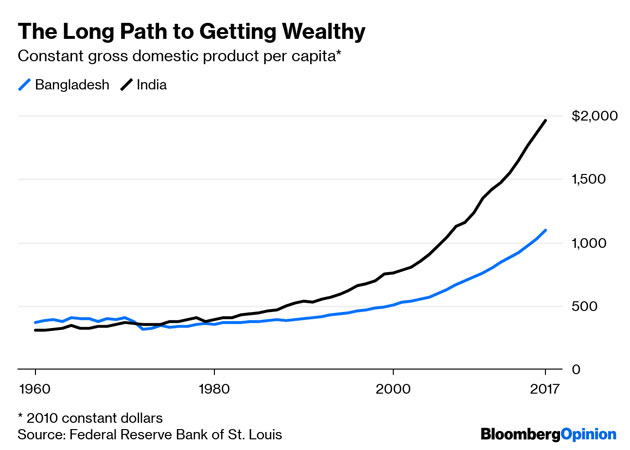For the most part, since Independence, on both these counts, India’s economy has been 10 times better than Bangladesh’s. Besides Bangladesh’s per capita income has come neck to neck with India, there are other factors from the Human Development Index that has offered enough ammunition for political attacks, and has open blame game sessions.
Comparison between Bangladesh and India; data from 2020
| S.no. | Parameters | % in Bangladesh | % in India |
| 1 | Average birth rate | 2.1 | 2.3 |
| 2 | per capita GDP ($) | 1887.97 | 1876.63 |
| 3 | Female literacy rate | 71% | 65% |
| 4 | GDP growth rate | 3.8% | -10.29 |
| 5 | Global Peace Index rank | 97 | 139 |
| 6 | Life expectancy | 72 yrs | 69 yrs |
| 7 | Unemployment | 4% | 8% |
| 8 | Social Hostilities Index | 7.2 | 9.5 |
These facts are not to show that Bangladesh is a better country. It is to show how far they have come. They used to be worse than India in all these parameters, but now are better because they focused on the right things.
But the question arises why are we even considering these comparisons made between India and Bangladesh?
How this debate caught everyone’s attention these days?
Let’s dig deeper with TSA to understand the chronology of this event.
Under World Economic Outlook October 2020 a report titled ‘A Long and Difficult Ascent’ was released by the International Monetary Fund (IMF) last Wednesday, on 14th October 2020.
The October outlook shows a contraction of a further 5% more than assumed in June. The 2020 projection for India is a downgrade of -5.8 percentage points from the IMF’s June projection for the country. It has gone down to -10.23% in October. But more than the sharp contraction, what caught everyone’s attention is that an average Bangladeshi citizen’s per capita income would be more than the average Indian citizen’s per capita income in 2020.
The report shows the index of Bangladesh that is smaller in area and population has been lower in the economic stand since its inception. Now in the pandemic year 2020, Bangladesh has outnumbered the statistics. It is performing way better than India, according to graphs presented by IMF.
To interpret current data, we will have to understand the backstory, the figures from 1982 onward.

A fair comparison is made between countries by looking at its GDP. The figures drawn above, project the performance of the two countries, namely India and Bangladesh. All three charts drafted within a timeline of 1982 to 2025. Chart 1 and chart 2 shows the GDP growth rate and absolute GDP.
There is no doubt Bangladesh has always been on improving its accomplishment. Nonetheless, the gap between India and Bangladesh remains 10 times higher. Some obvious factors are duly responsible for maintaining this difference. Area, diversity, and size of the population play a major role in reflecting this disparity.

For right now, let’s consider all of these details as a constant variable. The dubious phenomenon of GDP per capita has made it into a controversy. In chart 3, the graph of Bangladesh sketched to overlap India’s per capita in the current year 2020. The reason behind this could be understood as follows.
- The growth rate of Bangladesh is constantly rising. Unequivocally, it is in no way in a position to compare the gap between the two. However, the decline of India in growth rate from 2017 has made it possible for Bangladesh to make a comparison with India. To its contradiction, at the same time, the other country was gaining ground.
- The other factor is the size of the population. Within 15 years, India’s population has grown at a faster rate of 21%, while Bangladesh’s rate has been 18%.
- The combination of these two factors has already brought Bangladesh’s economy near to 50% with India. In 2014 Bangladesh has attained roughly 70% of India’s figure. Since then the gap has moved considerably close enough to India.
- Finally, the relative effect of Covid-19 on the two economies in 2020 was the most immediate consideration. Although India’s GDP is set to decrease by 10%, it is projected that Bangladesh’s GDP will increase by almost 4%. In other words, Bangladesh is saving graces, while India is one of the worst affected economies.
In this context, several other relevant questions have arisen whilst their discussion becomes important to understand the ongoing debate.
- Being a smaller country from the subcontinent, how does it even manage to equate with India?
While the neighbouring country from which it got independence was busy in creating controversies over grabbing Kashmir, terrorism, nuclear weapons, etc., Bangladesh was working hard attaining progressive figures. The labour law allowed open trade and also the laws are not as stringent as other subcontinent countries. This has impacted women’s participation in small businesses. Moreover, Several social and political indicators, such as hygiene, sanitation, financial inclusion, and political representation of women have improved. The garment industry, where women workers gave Bangladesh the edge to corner the worldwide export markets from which China withdrew, was a major driver of economic growth. It also helps to ensure productivity as Bangladesh’s economy is organized in such a way that its GDP is dominated by the manufacturing sector, followed by services. These two sectors produce a lot of employment and are more lucrative than agriculture. India, on the other hand, has struggled to improve its industrial sector and is still dependent on agriculture so far.
- Is India again supposed to regain the lead?
Yes, for sure. The IMF’s forecasts suggest that India is likely to expand faster next year and that it is likely to rise again. Although, given Bangladesh’s lower population growth and faster economic growth, in terms of per capita income, India and Bangladesh are likely to be neck and neck for the near future.








